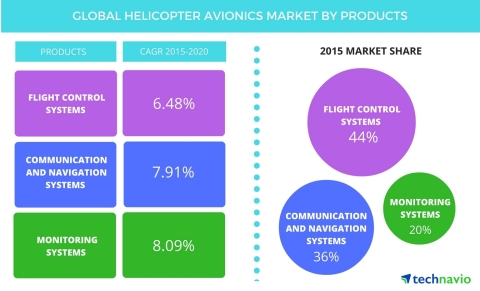LONDON--(BUSINESS WIRE)--According to the latest market study released by Technavio, the global helicopter avionics market is expected to reach USD 1,998 billion by 2020, growing at a CAGR of almost 10%.
This research report titled ‘Global Helicopter Avionics Market 2016-2020’ provides an in-depth analysis of the market in terms of revenue and emerging market trends. The report provides a comprehensive overview of the global helicopter avionics market, market shares, growth prospects by product (flight control systems [FCS], communication and navigation systems, and monitoring systems) and growth opportunities by region (the Americas, EMEA, and APAC).
Significant advances in technology in the field of avionics are a major driving factor for many of the helicopter modernization initiatives. For example, Boeing, National Aeronautics and Space Administration (NASA), and Rockwell Collins have collaborated to innovate cockpit avionics systems like autopilots, cockpit displays, and FCS. Avionics systems play a major role in the efficient movement of aircraft, and these systems need to be upgraded at regular intervals to ensure the safety of the passengers and crew.
Request a sample report: http://www.technavio.com/request-a-sample?report=54499
Technavio’s sample reports are free of charge and contain multiple sections of the report including the market size and forecast, drivers, challenges, trends, and more.
Technavio’s aerospace and defense analysts categorize the global helicopter avionics market into three major segments by product. They are:
- Flight control systems (FCS)
- Communication and navigation systems
- Monitoring systems
Helicopter avionics market in FCS
Integration of AFCS has enabled automation for several systems, thereby improving helicopter stability and reducing crew workload. AFCS is equipped with sensors that deliver data relating to flight speed, payload, navigational information, engine controls, airspeed, and altitude. Most of the artificial feel systems are presently being controlled by the FCS. For instance, the flight warning systems alert the pilot when the distance between the helicopter and terrain is inappropriate and requires attention. Likewise, autopilot systems enable automatic tracking and point-to-point navigation, ensuring safe helicopter operations.
According to Avimanyu Basu, a lead aerospace components analyst from Technavio, “AFCS is driving the market with its wide range of safety and reliable features. Currently, a wide range of systems such as visual flight rules systems, stability augmentation, and autopilot systems are combined into one AFCS system. This system also comprises digital flight guidance system and digital FCS for helicopters.”
Helicopter avionics market in communication and navigation systems
Communication systems enable data transfer between ground bases and helicopters using radio transmitters and radio receivers. The installation of satellite communication (SATCOM) systems enhances reliable communications. SATCOM links are one of the several kinds of long-distance communications links that interconnect communications centers across the world. These links are part of the defense satellite communication system and fleet SATCOM.
“In telemetry, SATCOM data links assist in uploading real time weather data from any remote area of the world. They are also used for long-range, cross-continent telemetry applications. The US Army used the DLS-1000 Series data link system, developed by Aero Telemetry to implement a tactical meteorological system on its Predator unmanned aerial vehicle,” says Avimanyu.
Helicopter avionics market in monitoring systems
Avionic systems aid cockpit displays by providing flight route pictures as well as flight instrument data. These displays project information such as speed, position, altitude, vertical rate, and GPS active waypoint. For example, Garmin develops the G500H flight display that features LCD screens with multi-functional display on the left and primary flight display on the right.
For the past 10 years, NASA has been focusing on SVS-related research programs in collaboration with researchers from the US Department of Defense (DoD), FAA, NASA’s Langley Research Center, Avionics Engineering Center for Synthetic Vision Research, and other industry stakeholders. Millions of dollars are being invested in this project, which aims to develop advanced synthetic vision systems (SVS) for aviation applications.
The top vendors highlighted by Technavio’s research analysts in this report are:
- Aspen Avionics
- Garmin
- Honeywell International
- Rockwell Collins
- Thales
Browse Related Reports:
- Global Military Aircraft Avionics Market 2017-2021
- Global Military Helicopter MRO Market 2016-2020
- Global Civil Helicopter MRO Market 2016-2020
Do you need a report on a market in a specific geographical cluster or country but can’t find what you’re looking for? Don’t worry, Technavio also takes client requests. Please contact enquiry@technavio.com with your requirements and our analysts will be happy to create a customized report just for you.
About Technavio
Technavio is a leading global technology research and advisory company. The company develops over 2000 pieces of research every year, covering more than 500 technologies across 80 countries. Technavio has about 300 analysts globally who specialize in customized consulting and business research assignments across the latest leading edge technologies.
Technavio analysts employ primary as well as secondary research techniques to ascertain the size and vendor landscape in a range of markets. Analysts obtain information using a combination of bottom-up and top-down approaches, besides using in-house market modeling tools and proprietary databases. They corroborate this data with the data obtained from various market participants and stakeholders across the value chain, including vendors, service providers, distributors, re-sellers, and end-users.
If you are interested in more information, please contact our media team at media@technavio.com.




